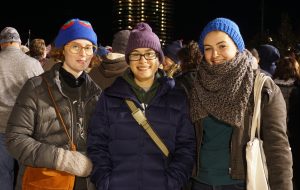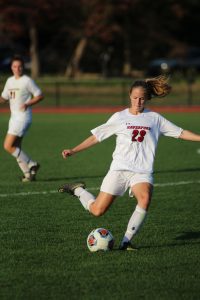By Staff Writer Rachel Hertzenberg
The history of field hockey in the United States has its roots at Bryn Mawr. Constance Applebee, the namesake of Applebee Field, and Bryn Mawr’s athletic director in the early twentieth century, is credited with introducing the sport to the United States. Over a century later, the Bryn Mawr field hockey team is emerging from a tumultuous period. After their previous coach’s contract with Bryn Mawr was terminated last February, assistant coaches were forced to pick up the slack in recruiting high school students for this year. Although there are four first year students currently on the team, the entire roster has shrunk down to just sixteen athletes. According to captain Haley Newman ‘17, it often takes several years for a program to be rebuilt after the loss of a coach. Nonetheless, Newman is confident that the team is “on the up-and-up,” largely due to the June hiring of coach Victor Brady (Swarthmore ‘13). Newman, along with her co-captain Holly Senebandith ‘17, expressed excitement over the team’s future with Brady. Not only is Brady “ambitious, determined, [with] a ton of experience in the field hockey world,” but he already has lined up “phenomenal recruits,” according to Newman. Both Newman and Senebandith say that Brady’s coaching has led to a markedly more positive and supportive atmosphere on the team.
![]()
Although the team has faced difficulties this season, Newman and Senebandith spoke enthusiastically about their September 17 2-3 game against Wells College, which went into double overtime. “Everyone left everything on the field,” says Newman, “the skill was amazing to see and be a part of.” Senebandith agreed, saying that the game was “one of those experiences where you’re so proud to play for Bryn Mawr.” Despite the setbacks of the small roster and string of losses–although, as a part of the elite Centennial Conference, Bryn Mawr’s field hockey team is competing among some of the best small college teams in the country–the team has pulled together to form a close-knit community. In fact, the small size of the team has helped to strengthen these bonds, and push each athlete to excel. Senebandith says that “the personality of our team is one of the things that’s kept me here at Bryn Mawr.”
Brady’s coaching seems to be paying off strategically. This season, the team has scored six times more shots total and eleven times more shots on goal than in any other season. They have also been awarded fourteen times as many offensive corners, which allows them to shoot at the defensive team’s goal with as many players as they want. Similarly, the team has had the fewest defensive penalty corners ever, meaning that opposing teams have had a hard time attacking Bryn Mawr’s shooting circle. Specifically, the defensive penalties against Bryn Mawr’s team have decreased by over 40% per game. This is especially remarkable given the small roster. The team’s goals against average (GAA) has dropped by 3.38, meaning that on average, 3.38 fewer goals are scored against Bryn Mawr per game.
With the big win in their last game of the season to send off the seniors in the program, the focus for the program is now on recruiting new Owls to come to Bryn Mawr to play field hockey and join the program.
Photo courtesy of Bryn Mawr Athletics


